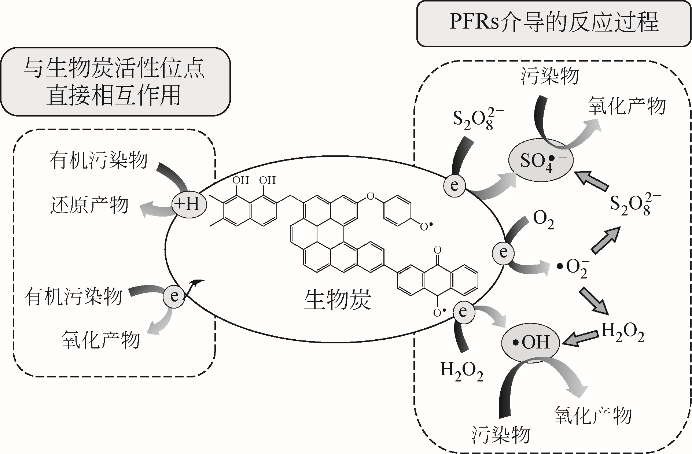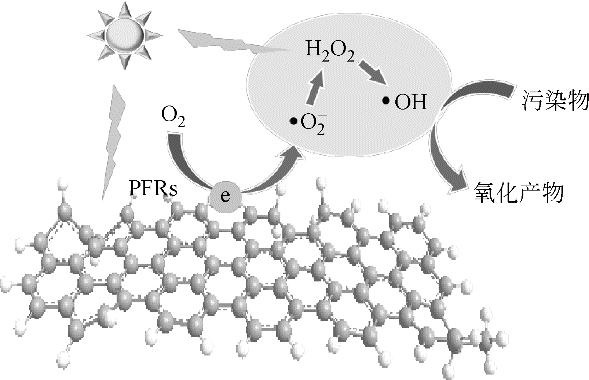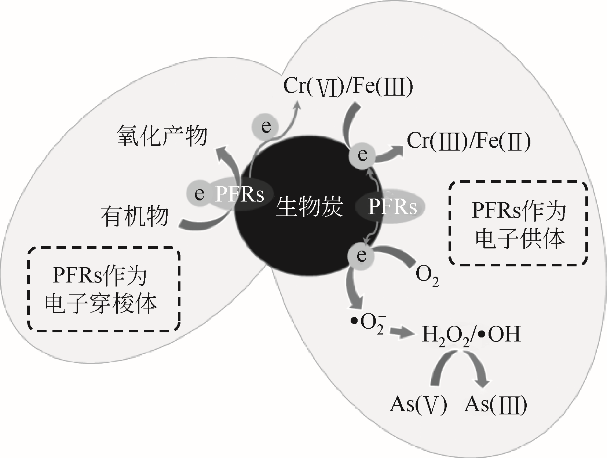化工进展 ›› 2020, Vol. 39 ›› Issue (4): 1521-1527.DOI: 10.16085/j.issn.1000-6613.2019-1284
生物炭持久性自由基形成机制及环境应用研究进展
- 1.东华大学环境科学与工程学院,上海 201620
2.西北农林科技大学资源环境学院,陕西 杨凌 712100
-
收稿日期:2019-08-09出版日期:2020-04-05发布日期:2020-04-28 -
通讯作者:高品 -
作者简介:唐正(1992—),男,博士研究生,研究方向为土壤污染修复技术。E-mail:runner92@163.com 。 -
基金资助:广西创新驱动发展专项资金项目(桂科AA17204076)
Formation mechanisms and environmental applications of persistent free radicals in biochar: a review
Zheng TANG1( ),Song ZHAO2,Yajie QIAN1,Gang XUE1,Hanzhong JIA2,Pin GAO1(
),Song ZHAO2,Yajie QIAN1,Gang XUE1,Hanzhong JIA2,Pin GAO1( )
)
- 1.College of Environmental Science and Engineering, Donghua University, Shanghai 201620, China
2.College of Natural Resources and Environment, Northwest A & F University, Yangling 712100, Shaanxi, China
-
Received:2019-08-09Online:2020-04-05Published:2020-04-28 -
Contact:Pin GAO
摘要:
持久性自由基(PFRs)因其持续反应活性和潜在毒性而日益受到广泛关注。生物炭在高温热解和水热碳化制备过程中会产生PFRs,并可转化形成活性氧物质,从而促进环境污染物的氧化还原转化和降解,同时也产生潜在的环境健康风险。本文综述了生物炭PFRs的国内外研究进展,归纳了PFRs在生物炭制备过程中的形成和转化机制,总结了生物炭PFRs生成ROS降解有机污染物、光诱导氧化降解有机污染物、重金属氧化还原转化等方面的环境应用研究现状,初步探讨了生物炭PFRs的毒性效应,并对今后的研究发展方向提出了展望,以期为生物炭PFRs的进一步环境应用提供方向和依据。
中图分类号:
引用本文
唐正,赵松,钱雅洁,薛罡,贾汉忠,高品. 生物炭持久性自由基形成机制及环境应用研究进展[J]. 化工进展, 2020, 39(4): 1521-1527.
Zheng TANG,Song ZHAO,Yajie QIAN,Gang XUE,Hanzhong JIA,Pin GAO. Formation mechanisms and environmental applications of persistent free radicals in biochar: a review[J]. Chemical Industry and Engineering Progress, 2020, 39(4): 1521-1527.
| 1 | ARANGIO A M, TONG H, SOCORRO J, et al. Quantification of environmentally persistent free radicals and reactive oxygen species in atmospheric aerosol particles[J]. Atmospheric Chemistry and Physics, 2016, 16(20): 13105-13119. |
| 2 | YANG L L, LIU G R, ZHENG M H, et al. Highly elevated levels and particle-size distributions of environmentally persistent free radicals in haze-associated atmosphere[J]. Environmental Science & Technology, 2017, 51(14): 7936-7944. |
| 3 | CHEN Q C, SUN H Y, MU Z, et al. Characteristics of environmentally persistent free radicals in PM2.5: concentrations, species and sources in Xi’an, Northwestern China[J]. Environmental Pollution, 2019, 247: 18-26. |
| 4 | DELA CRUZ A L N, GEHLING W, LOMNICKI S, et al. Detection of environmentally persistent free radicals at a superfund wood treating site[J]. Environmental Science & Technology, 2011, 45(15): 6356-6365. |
| 5 | JIA H Z, ZHAO S, NULAJI G, et al. Environmentally persistent free radicals in soils of past coking sites: distribution and stabilization[J]. Environmental Science & Technology, 2017, 51(11): 6000-6008. |
| 6 | VEJERANO E P, RAO G, KHACHATRYAN L, et al. Environmentally persistent free radicals: insights on a new class of pollutants[J]. Environmental Science & Technology, 2018, 52(5): 2468-2481. |
| 7 | 杨颖, 孙振亚. 一类新的环境有害物质——环境持久性自由基(EPFRs)的研究进展[J]. 矿物岩石地球化学通报, 2012, 31(3): 287-290. |
| YANG Ying, SUN Zhenya. The research progress on a new type harmful matter–environmental persistent free radicals (EPFRs)[J]. Bulletin of Mineralogy, Petrology and Geochemistry, 2012, 31(3): 287-290. | |
| 8 | DELLINGER B, LOMNICKI S, KHACHATRYAN L, et al. Formation and stabilization of persistent free radicals[J]. Proceedings of the Combustion Institute, 2007, 31(1): 521-528. |
| 9 | TRUONG H, LOMNICKI S, DELLINGER B. Mechanisms of molecular product and persistent radical formation from the pyrolysis of hydroquinone[J]. Chemosphere, 2008, 71(1): 107-113. |
| 10 | GAO P, YAO D C, QIAN Y J, et al. Factors controlling the formation of persistent free radicals in hydrochar during hydrothermal conversion of rice straw[J]. Environmental Chemistry Letters, 2018, 16(4): 1463-1468. |
| 11 | KHACHATRYAN L, VEJERANO E, LOMNICKI S, et al. Environmentally persistent free radicals (EPFRs). 1. Generation of reactive oxygen species in aqueous solutions[J]. Environmental Science & Technology, 2011, 45(19): 8559-8566. |
| 12 | GEHLING W, KHACHATRYAN L, DELLINGER B. Hydroxyl radical generation from environmentally persistent free radicals (EPFRs) in PM2.5[J]. Environmental Science & Technology, 2014, 48(8): 4266-4272. |
| 13 | KELLEY M A, HEBERT V Y, THIBEAUX T M, et al. Model combustion-generated particulate matter containing persistent free radicals redox cycle to produce reactive oxygen species[J]. Chemical Research in Toxicology, 2013, 26(12): 1862-1871. |
| 14 | SARAVIA J, LEE G I, LOMNICKI S, et al. Particulate matter containing environmentally persistent free radicals and adverse infant respiratory health effects: a review[J]. Journal of Biochemical and Molecular Toxicology, 2013, 27(1): 56-68. |
| 15 | 张绪超, 赵力, 陈懿, 等. 环境持久性自由基及其介导的生物学损伤[J]. 中国环境科学, 2019, 39(5): 2180-2189. |
| ZHANG Xuchao, ZHAO Li, CHEN Yi, et al. Overlooked risks and influences of environmentally persistent free radicals in the ambient media[J]. China Environmental Science, 2019, 39(5): 2180-2189. | |
| 16 | WOOLF D, AMONETTE J E, STREET-PERROTT F A, et al. Sustainable biochar to mitigate global climate change[J]. Nature Communications, 2010, 1: 56. |
| 17 | STEINBEISS S, GLEIXNER G, ANTONIETTI M. Effect of biochar amendment on soil carbon balance and soil microbial activity[J]. Soil Biology and Biochemistry, 2009, 41(6): 1301-1310. |
| 18 | AHMAD M, RAJAPAKSHA A U, LIM J E, et al. Biochar as a sorbent for contaminant management in soil and water: a review[J]. Chemosphere, 2014, 99: 19-33. |
| 19 | XIE T, REDDY K R, WANG C W, et al. Characteristics and applications of biochar for environmental remediation: a review[J]. Critical Reviews in Environmental Science and Technology, 2015, 45(9): 939-969. |
| 20 | KAMBO H S, DUTTA A. A comparative review of biochar and hydrochar in terms of production, physico-chemical properties and applications[J]. Renewable and Sustainable Energy Reviews, 2015, 45: 359-378. |
| 21 | QIN Y, LI G, GAO Y, et al. Persistent free radicals in carbon-based materials on transformation of refractory organic contaminants(ROCs) in water: a critical review[J]. Water Research, 2018, 137: 130-143. |
| 22 | RUAN X, SUN Y, DU W, et al. Formation, characteristics, and applications of environmentally persistent free radicals in biochars: a review[J]. Bioresource Technology, 2019, 281: 457-468. |
| 23 | FANG G D, LIU C, GAO J, et al. Manipulation of persistent free radicals in biochar to activate persulfate for contaminant degradation[J]. Environmental Science & Technology, 2015, 49(9): 5645-5653. |
| 24 | FANG G D, GAO J, LIU C, et al. Key role of persistent free radicals in hydrogen peroxide activation by biochar: implications to organic contaminant degradation[J]. Environmental Science & Technology, 2014, 48(3): 1902-1910. |
| 25 | LIAO S, PAN B, LI H, et al. Detecting free radicals in biochars and determining their ability to inhibit the germination and growth of corn, wheat and rice seedlings[J]. Environmental Science & Technology, 2014, 48(15): 8581-8587. |
| 26 | LIEKE T, ZHANG X, STEINBERG C E W, et al. Overlooked risks of biochars: persistent free radicals trigger neurotoxicity in Caenorhabditis elegans[J]. Environmental Science & Technology, 2018, 52(14): 7981-7987. |
| 27 | 张绪超, 陈懿, 胡蝶, 等. 生物炭中环境持久性自由基对秀丽隐杆线虫的毒性[J]. 中国环境科学, 2019, 39(6): 2644-2651. |
| ZHANG Xuchao, CHEN Yi, HU Die, et al. Neurotoxic effect of environmental persistent free radicals in rice biochar to Caenorhabditis elegans[J]. China Environmental Science, 2019, 39(6): 2644-2651. | |
| 28 | 杨莉莉, 郑明辉, 许杨, 等. 环境持久性自由基的污染特征与生成机理[J]. 中国科学: 化学, 2018, 48(10): 1226-1235. |
| YANG Lili, ZHENG Minghui, XU Yang, et al. Pollution characteristics and formation mechanism of environmentally persistent free radicals[J]. Scientia Sinica: Chimica, 2018, 48(10): 1226-1235. | |
| 29 | 韩林, 陈宝梁. 环境持久性自由基的产生机理及环境化学行为[J]. 化学进展, 2017, 29(9): 1008-1020. |
| HAN Lin, CHEN Baoliang. Generation mechanism and fate behaviors of environmental persistent free radicals[J]. Progress in Chemistry, 2017, 29(9): 1008-1020. | |
| 30 | 王朋, 吴敏, 李浩, 等. 环境持久性自由基对有机污染物环境行为的影响研究进展[J]. 化工进展, 2017, 36(11): 4143-4149. |
| WANG Peng, WU Min, LI Hao, et al. Formation of environmental persistent free radicals and its influence on organic pollutant behavior: a review[J]. Chemical Industry and Engineering Progress, 2017, 36(11): 4143-4149. | |
| 31 | JIA H Z, ZHAO S, SHI Y F, et al. Transformation of polycyclic aromatic hydrocarbons and formation of environmentally persistent free radicals on modified montmorillonite: the role of surface metal ions and polycyclic aromatic hydrocarbon molecular properties[J]. Environmental Science & Technology, 2018, 52(10): 5725-5733. |
| 32 | DELA CRUZ A L N, COOK R L, DELLINGER B, et al. Assessment of environmentally persistent free radicals in soils and sediments from three superfund sites[J]. Environmental Science: Processes & Impacts, 2014, 16(1): 44-52. |
| 33 | GEHLING W, DELLINGER B. Environmentally persistent free radicals and their life-times in PM2.5 [J]. Environmental Science & Technology, 2013, 47(15): 8172-8178. |
| 34 | VEJERANO E, LOMNICKI S M, DELLINGER B. Formation and stabilization of combustion-generated, environmentally persistent radicals on Ni(Ⅱ)O supported on a silica surface[J]. Environmental Science & Technology, 2012, 46(17): 9406-9411. |
| 35 | YAN Y, MA X L, CAO W M, et al. Identifying the reducing capacity of biomass derived hydrochar with different post-treatment methods[J]. Science of the Total Environment, 2018, 643: 486-495. |
| 36 | KIRURI L W, KHACHATRYAN L, DELLINGER B, et al. Effect of copper oxide concentration on the formation and persistency of environmentally persistent free radicals(EPFRs) in particulates[J]. Environmental Science & Technology, 2014, 48(4): 2212-2217. |
| 37 | YANG L, LIU G, ZHENG M, et al. Pivotal roles of metal oxides in the formation of environmentally persistent free radicals[J]. Environmental Science & Technology, 2017, 51(21): 12329-12336. |
| 38 | JIA H Z, NULAJI G, GAO H W, et al. Formation and stabilization of environmentally persistent free radicals induced by the interaction of anthracene with Fe(Ⅲ)-modified clays[J]. Environmental Science & Technology, 2016, 50(12): 6310-6319. |
| 39 | JIA H Z, ZHAO S, SHI Y F, et al. Mechanisms for light-driven evolution of environmentally persistent free radicals and photolytic degradation of PAHs on Fe(Ⅲ)-montmorillonite surface[J]. Journal of Hazardous Materials, 2019, 362: 92-98. |
| 40 | HALE S E, LEHMANN J, RUTHERFORD D, et al. Quantifying the total and bioavailable polycyclic aromatic hydrocarbons and dioxins in biochars[J]. Environmental Science & Technology, 2012, 46(5): 2830-2838. |
| 41 | KAN T, STREZOV V, EVANS T J. Lignocellulosic biomass pyrolysis: a review of product properties and effects of pyrolysis parameters[J]. Renewable and Sustainable Energy Reviews, 2016, 57: 1126-1140. |
| 42 | GAO P, ZHOU Y Y, MENG F, et al. Preparation and characterization of hydrochar from waste eucalyptus bark by hydrothermal carbonization[J]. Energy, 2016, 97: 238-245. |
| 43 | VOLPE R, MENENDEZ J M B, REINA T R, et al. Free radicals formation on thermally decomposed biomass[J]. Fuel, 2019, 255: 115802. |
| 44 | KIBET J, KHACHATRYAN L, DELLINGER B. Molecular products and radicals from pyrolysis of lignin[J]. Environmental Science & Technology, 2012, 46(23): 12994-13001. |
| 45 | TITIRICI M M, ANTONIETTI M. Chemistry and materials options of sustainable carbon materials made by hydrothermal carbonization[J]. Chemical Society Reviews, 2010, 39(1): 103-116. |
| 46 | LIU Z, QUEK A, HOEKMAN S K, et al. Production of solid biochar fuel from waste biomass by hydrothermal carbonization[J]. Fuel, 2013, 103: 943-949. |
| 47 | CHEN N, HUANG Y H, HOU X J, et al. Photochemistry of hydrochar: reactive oxygen species generation and sulfadimidine degradation[J]. Environmental Science & Technology, 2017, 51(19): 11278-11287. |
| 48 | QIN Y X, ZHANG L Z, AN T C. Hydrothermal carbon-mediated Fenton-like reaction mechanism in the degradation of alachlor: direct electron transfer from hydrothermal carbon to Fe(Ⅲ)[J]. ACS Applied Materials & Interfaces, 2017, 9(20): 17115-17124. |
| 49 | HU J, SHEN D K, WU S L, et al. Effect of temperature on structure evolution in char from hydrothermal degradation of lignin[J]. Journal of Analytical and Applied Pyrolysis, 2014, 106: 118-124. |
| 50 | SABIO E, ÁLVAREZ-MURILLO A, ROMÁN S, et al. Conversion of tomato-peel waste into solid fuel by hydrothermal carbonization: influence of the processing variables[J]. Waste Management, 2016, 47: 122-132. |
| 51 | BARBIER J, CHARON N, DUPASSIEUX N, et al. Hydrothermal conversion of lignin compounds. A detailed study of fragmentation and condensation reaction pathways[J]. Biomass and Bioenergy, 2012, 46: 479-491. |
| 52 | BARGMANN I, RILLIG M C, KRUSE A, et al. Effects of hydrochar application on the dynamics of soluble nitrogen in soils and on plant availability[J]. Journal of Plant Nutrition and Soil Science, 2014, 177(1): 48-58. |
| 53 | NIZAMUDDIN S, MUBARAK N M, TIRIPATHI M, et al. Chemical, dielectric and structural characterization of optimized hydrochar produced from hydrothermal carbonization of palm shell[J]. Fuel, 2016, 163: 88-97. |
| 54 | KHACHATRYAN L, DELLINGER B. Environmentally persistent free radicals (EPFRs)-2. Are free hydroxyl radicals generated in aqueous solutions?[J]. Environmental Science & Technology, 2011, 45(21): 9232-9239. |
| 55 | PAN B, LI H, LANG D, et al. Environmentally persistent free radicals: occurrence, formation mechanisms and implications[J]. Environmental Pollution, 2019, 248: 320-331. |
| 56 | FANG G, GAO J, DIONYSIOU D D, et al. Activation of persulfate by quinones: free radical reactions and implication for the degradation of PCBs[J]. Environmental Science & Technology, 2013, 47(9): 4605-4611. |
| 57 | YANG J, PAN B, LI H, et al. Degradation of p-nitrophenol on biochars: role of persistent free radicals[J]. Environmental Science & Technology, 2015, 50(2): 694-700. |
| 58 | YANG J, PIGNATELLO J J, PAN B, et al. Degradation of p-nitrophenol by lignin and cellulose chars: H2O2-mediated reaction and direct reaction with the char[J]. Environmental Science & Technology, 2017, 51(16): 8972-8980. |
| 59 | ZHU S S, HUANG X C, MA F, et al. Catalytic removal of aqueous contaminants on N-doped graphitic biochars: inherent roles of adsorption and nonradical mechanisms[J]. Environmental Science & Technology, 2018, 52(15): 8649-8658. |
| 60 | CHONG M N, JIN B, CHOW C W K, et al. Recent developments in photocatalytic water treatment technology: a review[J]. Water Research, 2010, 44(10): 2997-3027. |
| 61 | JI L W, LIN L, YU D, et al. Solvent-free in situ synthesis of flexible BiVO4/Bi2WO6: MWCNT, PET composites with superior mineralization potential for photocatalytic degradation of organic pollutants[J]. Materials Letters, 2018, 220: 94-98. |
| 62 | FANG G D, LIU C, WANG Y, et al. Photogeneration of reactive oxygen species from biochar suspension for diethyl phthalate degradation[J]. Applied Catalysis B: Environmental, 2017, 214: 34-45. |
| 63 | ZHONG D, ZHANG Y, WANG Y L, et al. Mechanistic insights into adsorption and reduction of hexavalent chromium from water using magnetic biochar composite: key roles of Fe3O4 and persistent free radicals[J]. Environmental Pollution, 2018, 243: 1302-1309. |
| 64 | ZHAO N, YIN Z, LIU F, et al. Environmentally persistent free radicals mediated removal of Cr(Ⅵ) from highly saline water by corn straw biochars[J]. Bioresource Technology, 2018, 260: 294-301. |
| 65 | XU X Y, HUANG H, ZHANG Y, et al. Biochar as both electron donor and electron shuttle for the reduction transformation of Cr(Ⅵ) during its sorption[J]. Environmental Pollution, 2019, 244: 423-430. |
| 66 | VAN DER ZEE F P, CERVANTES F J. Impact and application of electron shuttles on the redox (bio)transformation of contaminants: a review[J]. Biotechnology Advances, 2009, 27(3): 256-277. |
| 67 | XU S N, ADHIKARI D, HUANG R X, et al. Biochar-facilitated microbial reduction of hematite[J]. Environmental Science & Technology, 2016, 50(5): 2389-2395. |
| 68 |
ZHONG D L, JIANG Y, ZHAO Z Z, et al. pH dependence of arsenic oxidation by rice-husk-derived biochar: roles of redox-active moieties[J]. Environmental Science & Technology, DOI: 10.1021/acs.est.9b00756.
DOI |
| 69 | LI Y, YANG Y Q, SHEN F, et al. Mitigating biochar phytotoxicity via lanthanum(La) participation in pyrolysis[J]. Environmental Science and Pollution Research, 2017, 24(11): 10267-10278. |
| [1] | 戴欢涛, 曹苓玉, 游新秀, 徐浩亮, 汪涛, 项玮, 张学杨. 木质素浸渍柚子皮生物炭吸附CO2特性[J]. 化工进展, 2023, 42(S1): 356-363. |
| [2] | 王浩然, 殷全玉, 方明, 侯建林, 李军, 何斌, 张明月. 近临界水处理废弃烟梗工艺优化[J]. 化工进展, 2023, 42(9): 5019-5027. |
| [3] | 姜晶, 陈霄宇, 张瑞妍, 盛光遥. 载锰生物炭制备及其在环境修复中应用研究进展[J]. 化工进展, 2023, 42(8): 4385-4397. |
| [4] | 李艳玲, 卓振, 池亮, 陈曦, 孙堂磊, 刘鹏, 雷廷宙. 氮掺杂生物炭的制备与应用研究进展[J]. 化工进展, 2023, 42(7): 3720-3735. |
| [5] | 范思涵, 于国熙, 来超超, 何欢, 黄斌, 潘学军. 非生物改性对厌氧微生物产物光化学活性影响[J]. 化工进展, 2023, 42(4): 2180-2189. |
| [6] | 王玉, 余广炜, 江汝清, 黎长江, 林佳佳, 邢贞娇. 餐厨厌氧沼渣生物炭吸附盐酸环丙沙星[J]. 化工进展, 2023, 42(4): 2160-2170. |
| [7] | 王玉, 余广炜, 林佳佳, 黎长江, 江汝清, 邢贞娇, 余铖. 沼渣、飞灰和污泥生物炭制备建筑陶粒[J]. 化工进展, 2023, 42(2): 1039-1050. |
| [8] | 胡兆岩, 张景新, 何义亮. Fe负载污泥生物炭催化热解聚丙烯及产物特性[J]. 化工进展, 2023, 42(2): 631-640. |
| [9] | 王书燕, 张新波, 彭安萍, 刘阳, NGO HUU HAO, 郭文珊, 温海涛. 生物炭回收水中氮磷营养物质的研究进展与挑战[J]. 化工进展, 2023, 42(10): 5459-5469. |
| [10] | 苏景振, 詹健. 生物炭对水环境中微塑料的去除研究进展[J]. 化工进展, 2023, 42(10): 5445-5458. |
| [11] | 杨柳, 王名威, 张耀斌. 磁铁矿负载生物炭强化厌氧微生物处理2,4-二氯苯酚废水[J]. 化工进展, 2022, 41(9): 5065-5073. |
| [12] | 黄霞, 何莹莹, 张艺蝶, 杨殿海, 戴晓虎, 谢丽. 基于生物炭强化有机固废好氧堆肥资源化的研究进展[J]. 化工进展, 2022, 41(8): 4544-4554. |
| [13] | 李叶青, 羊省儒, 梁卓, 江皓, 徐泉, 周红军, 冯璐. 外源添加物强化聚氯乙烯水热碳化脱氯[J]. 化工进展, 2022, 41(5): 2706-2712. |
| [14] | 陈茂, 张鑫, 谢伟, 陈广辉, 李志礼. 生物炭/凹凸棒土的制备及对磺胺嘧啶的吸附[J]. 化工进展, 2022, 41(5): 2623-2635. |
| [15] | 潘伟亮, 吴齐叶, 曹云鹏, 张先炳, 古励, 何强. nZVI/BC与(Cu-Pd)/BC协同提高硝酸盐的去除和氮气的选择性[J]. 化工进展, 2022, 41(2): 981-989. |
| 阅读次数 | ||||||
|
全文 |
|
|||||
|
摘要 |
|
|||||


